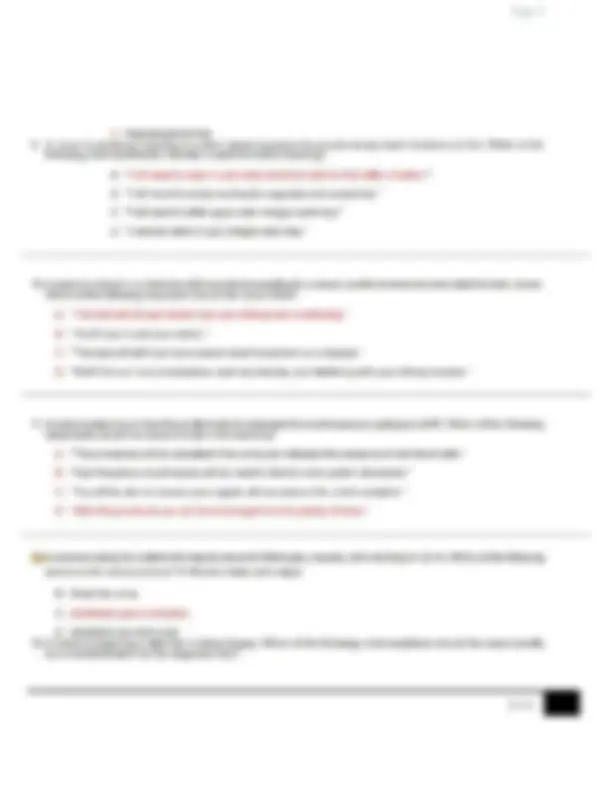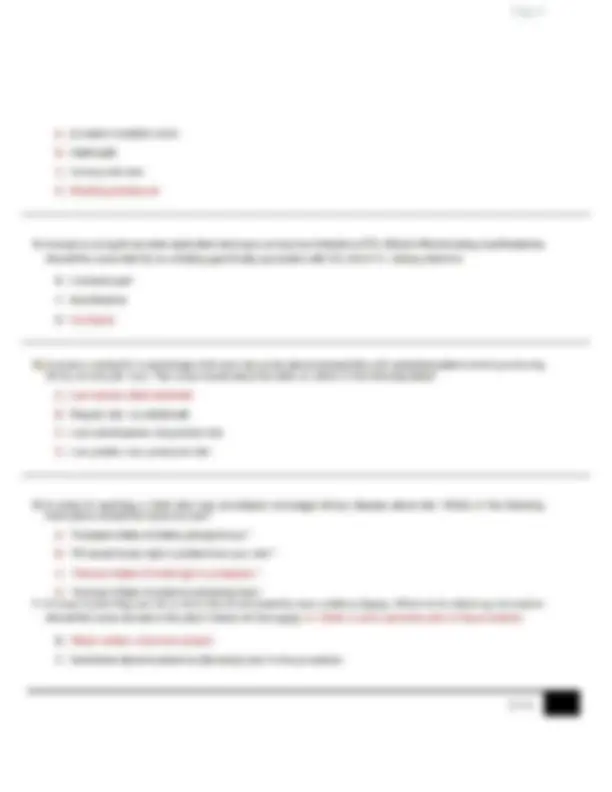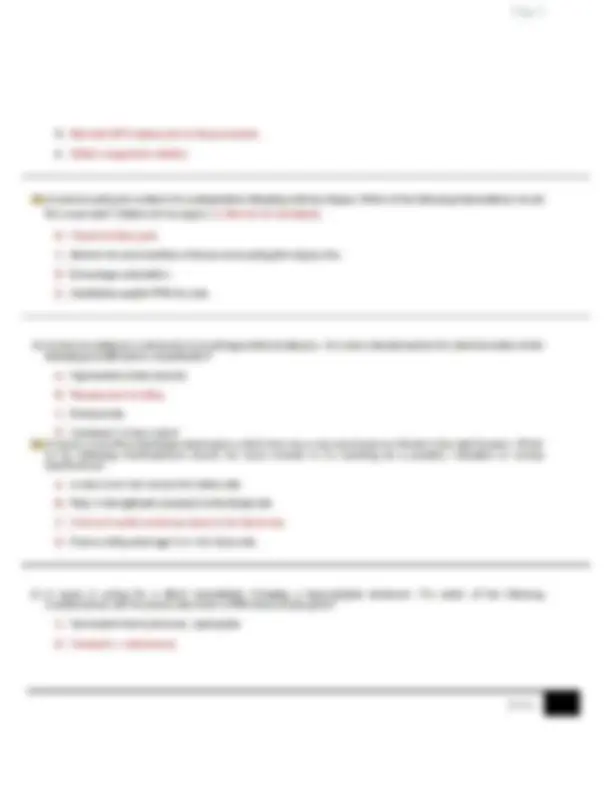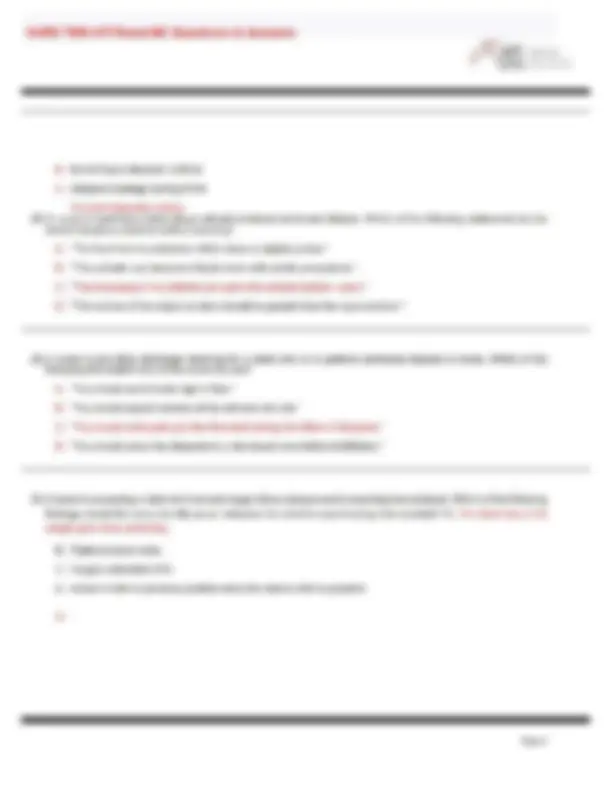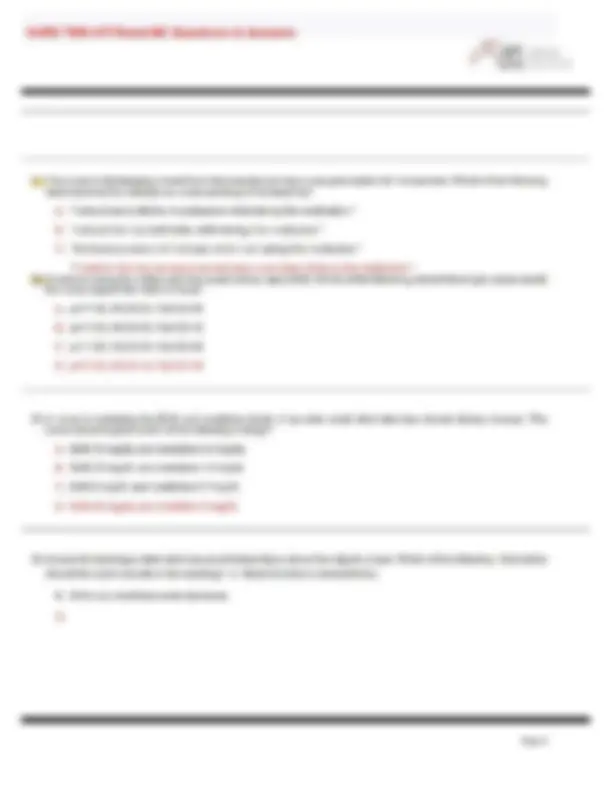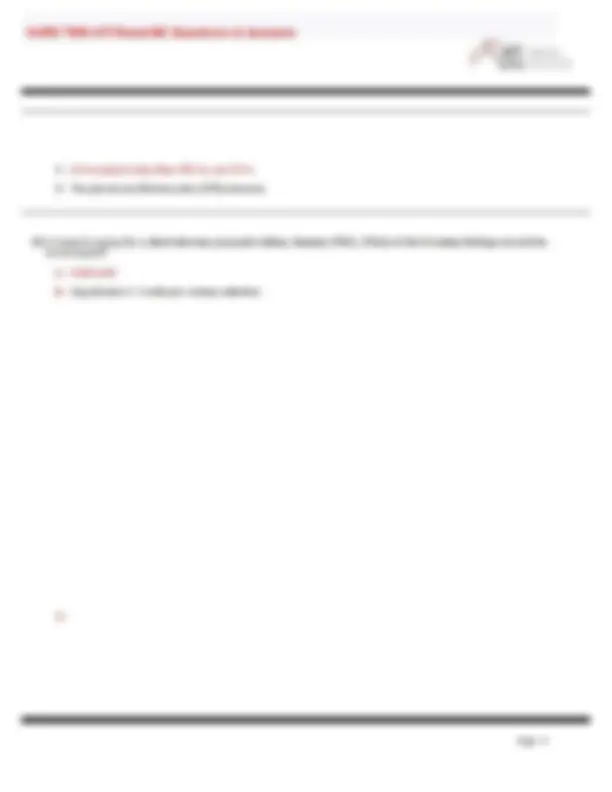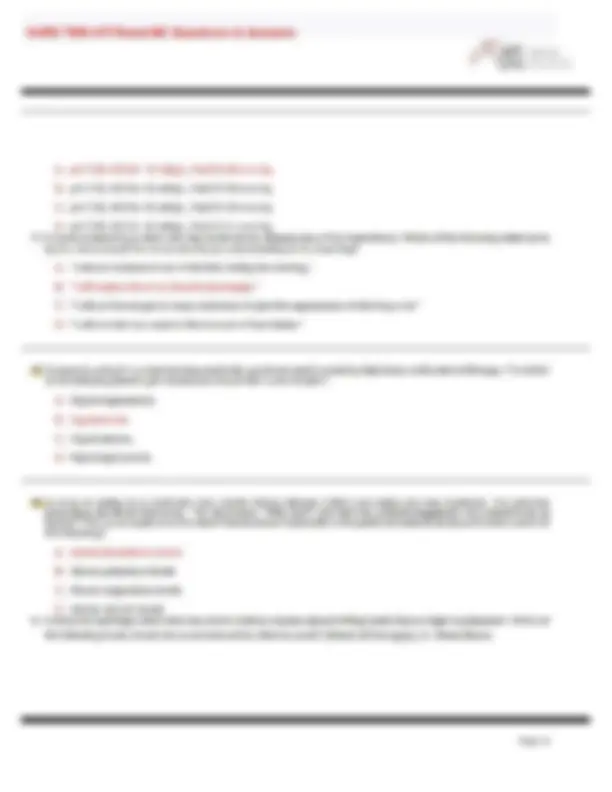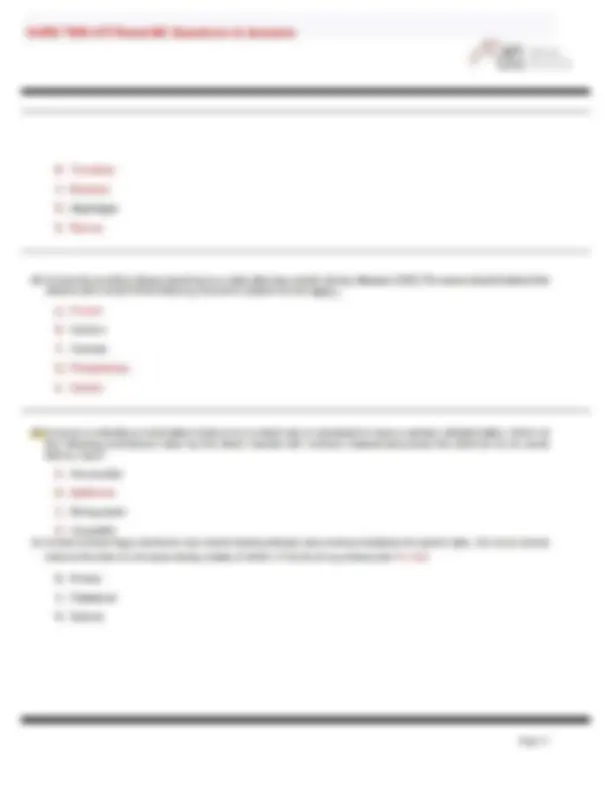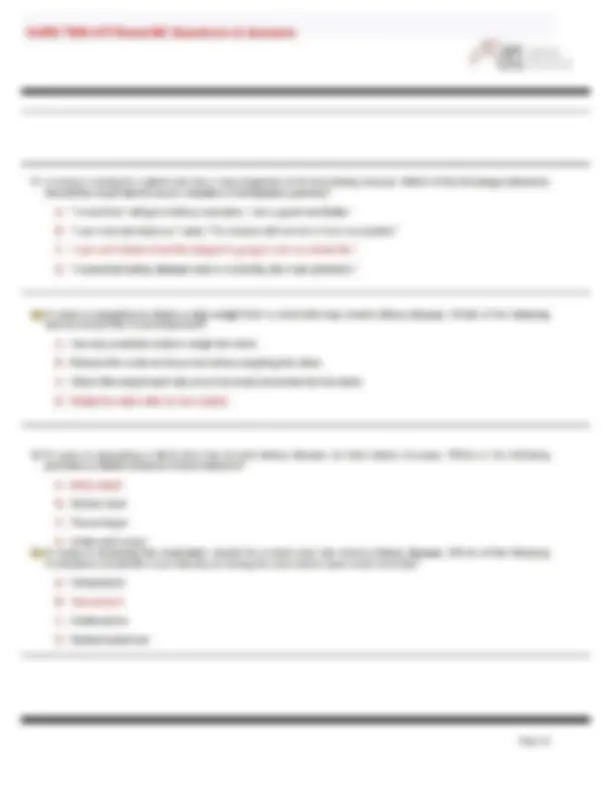Partial preview of the text
Download NURS 7950 ATI Renal MC Questions & Answers and more Exams Nursing in PDF only on Docsity!
1. A nurse is providing teaching to a client who has renal failure and an elevated phosphorous level. The provider instructed the client to take aluminum hydroxide 300 mg PO three times daily. For which of the following adverse effects should the nurse inform the client? A. Constipation B. Metallic taste C. Headache D. Muscle spasms 2. Anurse is caring for a client who has chronic renal disease and is receiving therapy with epoetin alfa. Which of the following laboratory results should the nurse review for an indication of a therapeutic effect of the medication? A. The leukocyte count B. The platelet count C. The hematocrit (Hct) D. The erythrocyte sedimentation rate (ESR) 3. A nurse is reviewing laboratory values for a client who has systemic lupus erythematosus (SLE). Which of the following values should give the nurse the best indication of the client's renal function? A. Serum creatinine B. Blood urea nitrogen (BUN) C. Serum sodium D. Urine-specific gravity 4. Anurse is caring for a client who has impaired renal function. For which of the following findings should the nurse notify the provider? A. Urine output of 175 mL in the past 8 hr B. Urine output of 2,200 mL in the past 24 hr C. First-voided urine in the morning has a strong odor D. Urine is cloudy after sitting in the urinal for 6 hr 5. Anurseis discussing kidney transplant with a client who has end-stage renal disease (ESRD). Which of the following should the nurse identify as a contraindication for this treatment? A. Breast cancer survivor for 8 years B. Pacemaker C. 65-years of age D. Alcohol use disorder 6. Anurse is discussing laboratory values associated with the renal system with a newly licensed nurse. Which of the following statements by the newly licensed nurse indicates an understanding of the values? A. Potassium levels are increased in clients who have polyuria. B. Specific gravity is decreased in clients who have hypovolemia. C. BUN is decreased in clients who have dehydration. D. Creatinine levels are increased in clients who have acute kidney injury. 7. A nurse is caring for a client who has end-stage renal disease (ESRD). Which of the following are expected findings? (Select all that apply). A. Slurred speech . Bone pain . Bradypnea. . Pruritus moon . Hypotension 8. Anurse is reviewing the laboratory test results from a client who has prerenal acute kidney injury (AKI). Which of the following electrolyte imbalances should the nurse expect? A. Hyperkalemia B. Hypernatremia C. Hypercalcemia A. Elevated creatinine level B. Flank pain C. Urinary retention D. Bleeding tendencies 14. Anurse is caring for an older adult client who has a urinary tract infection (UTI). Which of the following manifestations should the nurse identify as a finding specifically associated with this client? A. Urinary retention B. Low back pain C. Incontinence D. Confusion 15.A nurse is caring for a school-age child who has acute glomerulonephritis with peripheral edema and is producing 35 mL of urine per hour. The nurse should place the client on which of the following diets? A. Low-sodium, fluid-restricted B. Regular diet, no added salt C. Low-carbohydrate, low-protein diet D. Low-protein, low-potassium diet 16.A nurse is teaching a client who has pre-dialysis end-stage kidney disease about diet. Which of the following instructions should the nurse include? A. "Increase intake of dietary phosphorous." B. "Eliminate foods high in protein from your diet." C. "Reduce intake of foods high in potassium." D. "Increase intake of sodium-containing food." 17.A nurse is planning care for a client who is scheduled to have a kidney biopsy. Which of the following information should the nurse include in the plan? (Select all that apply). A. Obtain a urine specimen prior to the procedure. B. Obtain written, informed consent. C. Administer diphenhydramine (Benadry\) prior to the procedure. Page 5 D. Maintain NPO status prior to the procedure. E. Obtain coagulation studies. 18:A nurse is caring for a client 4 hr postoperative following a kidney biopsy. Which of the following interventions should the nurse take? (Select all that apply). A. Monitor for hematuria. B. Check for flank pain. C. Monitor for extravasation of tissue surrounding the biopsy site. D. Encourage ambulation. E. Administer aspirin PRN for pain. 19.A nurse is caring for a client who is receiving peritoneal dialysis. The nurse should monitor the client for which of the following manifestations of peritonitis? A. Hyperactive bowel sounds B. Nausea and vomiting C. Bradycardia D. Increased urinary output 20.A nurse is providing discharge teaching to a client who has a new arteriovenous fistula in the right forearm. Which of the following manifestations should the nurse include in the teaching as a possible indication of venous insufficiency? A. Araised red rash around the fistula site B. Pain in the right arm proximal to the fistula site C. Cold and numb numbness distal to the fistula site D. Foul-smelling drainage from the fistula site 21.A nurse is caring for a client immediately following a hemodialysis treatment. For which of the following manifestations will the nurse administer a PRN dose of phenytoin? A. Decreased blood pressure, rapid pulse B. Headache, restlessness NURS 7950 ATI Renal MC Questions & Answers Arai 24.A nurse is reviewing the laboratory data of a client following a hemodialysis treatment. The nurse should expect to find a decrease in which of the following laboratory values? A. RBC count B. Protein C. Calcium D . Potassium 25. nurse is teaching a client who has chronic kidney disease about the process of continuous ambulatory peritoneal dialysis (CAPD). Which of the following information should the nurse include in the teaching? A. CAPD filters the client's blood through an artificial device called a dialyzer. B. CAPD is the dialysis treatment of choice for clients who have a history of abdominal surgery. C. CAPD requires the client to follow fewer dietary and fluid restrictions than hemodialysis requires. D. CAPD requires a rigid schedule of exchange times. 26.A nurse is developing a plan of care for a client who is to begin receiving peritoneal dialysis. Which of the following interventions should the nurse implement to ensure proper dialysate exchange? A. Monitor vital signs every 2 hr during the procedure. B. Warm the dialysate solution prior to instillation. C. Place the drainage bag above the level of the client's abdomen. D. Maintain the client in a left lateral position during dialysis. 27.A nurse is caring for a client who is undergoing initial peritoneal dialysis. Which of the following should the nurse report immediately to the provider? a Report of discomfort during dialysate inflow Page 7 NURS 7950 ATI Renal MC Questions & Answers B. Blood-tinged dialysate outflow C. Dialysate leakage during inflow Purulent dialysate outflow 28.A nurse is teaching a client about self-administered peritoneal dialysis. Which of the following statements by the client indicates a need for further teaching? A. "The fluid from my abdomen will be clear or slightly yellow." B. "The catheter can become infected even with sterile precautions.” C. "The microwave in my kitchen can warm the solution before | use it." D . "The volume of the output solution should be greater than the input solution." 29.A nurse is providing discharge teaching for a client who is to perform peritoneal dialysis at home. Which of the following information should the nurse include? A. "You should avoid foods high in fiber." B. "You should expect redness at the catheter exit site." C. "You should anticipate pain the first week during the inflow of dialysate." D. "You should warm the dialysate in a microwave oven before instillation." 30.A nurse is assessing a client who has end-stage kidney disease and is receiving hemodialysis. Which of the following findings should the nurse identify as an indication the client is experiencing fluid overload? A. The client has a 5 |b weight gain since yesterday. B. Flattened neck veins C. Oxygen saturation 93% D. Return of skin to previous position when the client’s shin is palpated D. Page 8 NURS 7950 ATI Renal MC Questions & Answers att GC. Urine output is less than 400 mL per 24 hr. D. The glomerular filtration rate (GFR) recovers. 35.A nurse is caring for a client who has polycystic kidney disease (PKD). Which of the following findings should the nurse expect? A. Flank pain B. Hypotension C. Confusion Urinary retention Page 10 NURS 7950 ATI Renal MC Questions & Answers Arai 36.A nurse is assessing a client in the oliguric phase of acute kidney injury. Which of the following findings should the nurse expect? A. Decreased creatinine level B. Hyperkalemia C. Hypomagnesaemia D . Increased glomerular filtration rate (GFR) 37.A nurse is teaching a client who has acute kidney injury about dietary sources of potassium. Which of the following statements by the client indicates a need for clarification? A. "[ will enjoy eating cantaloupe for my morning snack." B. "I can easily add baked potatoes to my diet.” C. "Eating yogurt will be a new experience." D . "Adding pecans will be a change | can readily make." 38.A nurse is monitoring an alder adult female client who had a myocardial infarction (MI) for the development of an acute kidney injury. Which of the following findings should the nurse identify as indicating an increased risk of acute kidney injury (AKI)? A. Serum creatinine 1.8 mg/dL Serum Osmolality 290 mOsm/kg H20. . Blood urea nitrogen (BUN) 20mg/dL 90.8 . Magnesium 2.0 mEq/L 39.A nurse is reviewing laboratory findings for four clients. Which of the following clients has manifestations of acute kidney injury? A. BUN 15 mg/dL B. Serum creatinine 6 mg/dL Page 11 NURS 7950 ATI Renal MC Questions & Answers pH 7.25, HCO3- 19 mEq/L, PaCO2 30 mm Hg pH 7.30, HCO3- 26 mEq/L, PaCO2 50 mm Hg . pH 7.50, HCO3- 20 mEq/L, PaCO2 32 mm Hg D. pH 7.55, HCO3- 30 mEq/L, PaCO2 31 mm Hg 44. A nurse is teaching a client who has acute kidney disease about fluid restrictions. Which of the following statements by the client should the nurse identify as understanding of the teaching? oD > A. "| should consume most of the fluid during the evening.” B. "I will make a list of my favorite beverages." C. "Iwill put beverages in large containers to give the appearance of drinking a lot.” D . "| will not add ice cream to the amount of fluid intake." 45. A nurse is caring for a client wha has nephrotic syndrome and is receiving high-dose corticosteroid therapy. For which of the following electrolyte imbalances should the nurse monitor? A. Hypermagnesemia B. Hypokalemia C. Hyperkalemia D . _Hypomagnesemia 46.A nurse is caring for a client who has chronic kidney disease (CKD) and states she has heartburn. The provider prescribes aluminum hydroxide. The client asks, "Why can't | just take the antacid magaldrate my husband has at home?" The nurse explains to the client that aluminum hydroxide is the preferred antacid because it lowers which of the following? A. Serum phosphorus levels B. Serum potassium levels C. Serum magnesium levels D. Serum calcium levels 47.A nurse is teaching a client who has chronic kidney disease about limiting foods that are high in potassium. Which of the following foods should the nurse instruct the client to avoid? (Select all that apply.) A. Green Beans Page 13 NURS 7950 ATI Renal MC Questions & Answers B. Tomatoes C. Bananas D. Asparagus E. Raisins 48.A nurse is providing dietary teaching to a client who has chronic kidney disease (CKD). The nurse should instruct the client to limit which of the following nutrients? (Select all that apply.) A. Protein . Calcium . Calories . Phosphorous mooam Sodium 49:A nurse is collecting a medication history from a client who is scheduled to have a cardiac catheterization. Which of the following medications taken by the client interacts with contrast material and places the client at risk for acute kidney injury? A. Atorvastatin B. Metformin C. Nitroglycerin D. Carvedilol 50. A nurse is teaching a client who has chronic kidney disease and a new prescription for epoetin alfa. The nurse should instruct the client to increase dietary intake of which of the following substances? A. Iron B. Protein C. Potassium D. Sodium Page 14 
